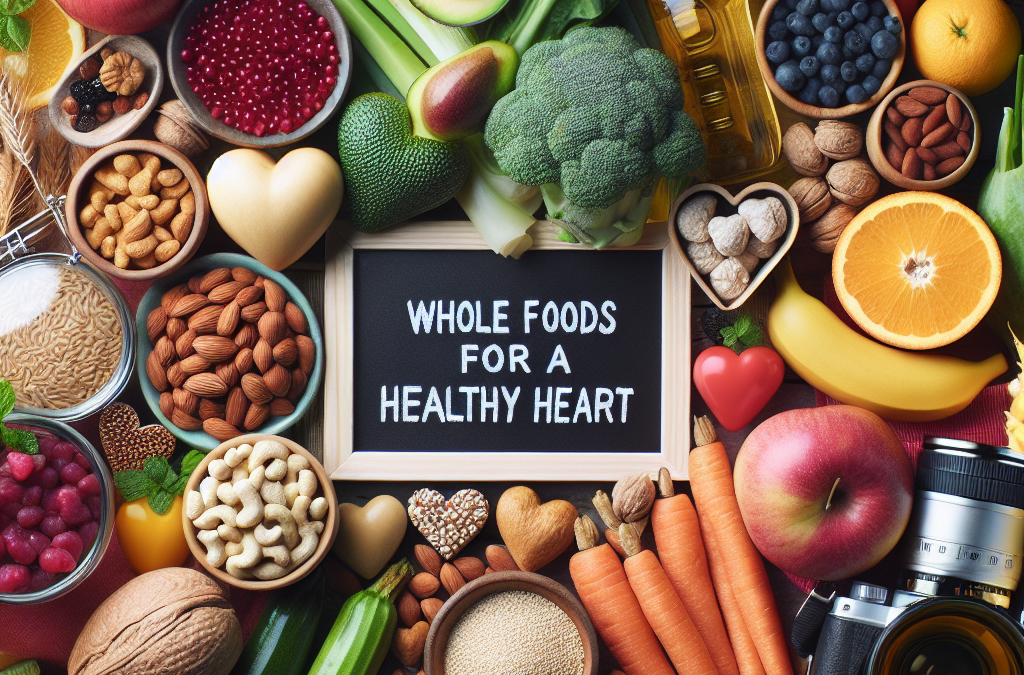Fruits and Vegetables
Why They Matter
When it comes to heart health, fruits and vegetables are like the superheroes of the food world. I always try to include a rainbow of fruits and veggies in my meals because they’re packed with vitamins, minerals, and antioxidants. These nutrients can help reduce inflammation and lower cholesterol levels, which is a win-win for our hearts!
Plus, the fiber found in fruits and vegetables aids digestion and keeps our cholesterol in check. I personally love snacking on fresh berries or tossing a colorful salad with leafy greens, peppers, and cucumbers. They’re not just eye-catching; they’re also heart-healthy!
Don’t forget about seasonal produce! It’s often fresher, tastier, and can sometimes save you a few bucks. So, check out your local farmer’s market or grocery store for what’s in season. I can’t express how refreshing it is to bite into a juicy summer peach or crisp autumn apple!
Best Options for Your Heart
Certain fruits and veggies are especially beneficial for heart health. Berries like blueberries and strawberries are fantastic due to their high levels of antioxidants. I often blend them into smoothies or just toss them in my oatmeal for a perfect breakfast!
Leafy greens such as spinach and kale are also amazing. They’re low in calories and high in essential nutrients. I like to add a handful of spinach to my morning omelet or make a simple kale salad with a squeeze of lemon juice and a pinch of salt.
Diving into citrus fruits, like oranges and grapefruits, not only zests up your day but also offers fantastic health benefits. Their vitamin C content is perfect for boosting your immune system and protecting your heart.
Easy Ways to Incorporate More
Getting more fruits and vegetables into your diet doesn’t have to be a chore. One of my go-to tricks is to prep them ahead of time. I wash and cut up a bunch of veggies at the beginning of the week, so they’re ready to grab when I’m in a pinch.
Also, try mixing different diced veggies into your dishes, like soups or stir-fries. They add flavor, color, and lots of nutrients! I’ve found that even simple pasta dishes can turn into something special with just a handful of veggies thrown in.
And don’t shy away from frozen options, either! They’re often just as nutritious as fresh produce and super convenient. I always keep a bag of frozen berries or mixed veggies in my freezer for smoothies or quick stir-fries whenever the mood strikes!
Whole Grains
The Benefits
Switching to whole grains has been a game-changer for me. Unlike refined grains, whole grains are packed with fiber and nutrients, which help lower cholesterol and control blood pressure. My go-to options are brown rice, quinoa, and oats. They keep me full longer and give me the energy I need throughout the day!
Fiber is fantastic for digestion, too. I’ve noticed that when I include more fiber in my diet, I feel more energized and less bloated. Plus, it can help with weight management—a win for both my heart and my waistline!
If you’re looking for heart-healthy food swaps, try replacing white bread with whole grain. I love the density and texture of whole grain bread in my sandwiches—it just feels healthier!
Delicious Whole Grain Options
Some whole grains are just downright delicious. Quinoa is one of my favorites—it’s super versatile, and I can add it to salads, bowls, or even use it in place of rice. It’s packed with protein, making it a great choice for vegetarians and meat-eaters alike.
Brown rice is another reliable option. I love making it into a hearty stir-fry with plenty of veggies. It’s filling, flavorful, and good for my heart! Not to mention, it’s one of those foods that could help stretch your budget while still eating healthy.
Don’t overlook oats, though! Overnight oats have become my morning ritual. Mixing oats with yogurt and fruit creates a quick breakfast that I can prepare the night before, which is perfect for busy mornings!
How to Add More Whole Grains to Your Diet
Incorporating whole grains into your meals can be easy! Start by making simple swaps—replace white pasta with whole-grain pasta. I noticed a difference in texture and taste that I genuinely enjoy. Plus, it just feels like I’m making healthier choices!
Another way is to experiment with new grains. You might find new favorites like farro or barley. I recently tried barley in a soup, and it added a lovely chewy texture that I didn’t expect. It’s all about having fun with your meals!
And, don’t forget about checking labels! When shopping for bread or cereals, make sure to read the ingredients—look for “100% whole grain” as the first ingredient. That has helped me steer clear of products that seem healthy but aren’t packed with the benefits I want.
Healthy Fats
Understanding Healthy Fats
Let’s clear the air around fats! Not all fats are created equal. Healthy fats, like those found in avocados, nuts, and olive oil, are essential for heart health. They help to lower bad cholesterol levels and provide essential fatty acids that our body needs.
I used to shy away from fats entirely, thinking they were the enemy. But incorporating healthy fats into my diet has actually improved my overall well-being. For instance, a drizzle of olive oil over my salads or grilled veggies can transform a simple dish!
Additionally, omega-3 fatty acids are a superstar when it comes to heart health. I love snacking on walnuts and adding chia seeds to smoothies or oatmeal to up my omega-3 game. They’re little boosts of goodness!
Best Sources of Healthy Fats
Let’s dive into some fantastic sources of healthy fats. Avocados are top-notch! I often mash them on toast or toss them in salads. They provide wonderful creaminess and pack a good dose of nutrients.
Get an Amazing Discount on the Best Certified Organic Whole Food Supplement!
Nuts and seeds are also great options. I always keep a mix of almonds, walnuts, and pumpkin seeds on hand for snacking. Not only do they satisfy my crunch cravings, but they also give my heart the boost it needs!
And let’s not forget about fatty fish, like salmon and mackerel. They’re rich in omega-3s. I try to incorporate fish into my meals at least once a week. Grilling some salmon with herbs and a squeeze of lemon is simple yet incredibly delicious.
Incorporating Healthy Fats into Your Diet
Adding healthy fats can be simple. One of my favorite things is making a homemade salad dressing with olive oil, vinegar, and spices. It’s fresh and way tastier than store-bought options!
You can also make smoothies by adding avocado or nut butter. It provides a creamy texture that is hard to beat. Plus, your smoothie can pack in more nutrients without compromising on flavor!
Lastly, don’t underestimate the power of snacking. Instead of reaching for potato chips, grab a handful of nuts or mix dried fruit with nut butter for a quick, healthy treat. You’ll be surprised at how satisfying they are!
Lean Proteins
The Importance of Lean Proteins
Protein is crucial for a healthy diet, especially for maintaining muscle mass and supporting overall health. However, choosing the right kind of protein is key! Lean proteins are lower in saturated fat, which makes them heart-healthy options.
Integrating more lean protein into my diet has not only helped with my energy levels but also keeps me feeling full. Whether I’m grilling chicken, baking fish, or mixing up some beans, these choices are tasty and better for my heart.
Plus, many lean proteins contain important nutrients and help regulate blood sugar levels. So, it’s a double win when I choose wisely!
Top Choices for Lean Proteins
Chicken breast and turkey are classic favorites for lean proteins. I often roast chicken with herbs or make ground turkey burgers. It feels indulgent while being heart-friendly!
Fish is definitely high on the list, and especially fatty fish like salmon or trout loaded with omega-3s. They’re quick to cook and always deliver amazing flavor. I could eat fish tacos all week!
For those who prefer plant-based options, legumes like lentils, chickpeas, and black beans are fantastic. They’re protein-rich and full of fiber, making them great for vegetarian and vegan diets. I love whipping up a hearty bean chili when I’m looking for comfort food!
Easy Ways to Add Lean Proteins to Meals
Incorporating lean proteins into meals can be a breeze. Start with meal prepping! Cooking a batch of chicken or fish at the beginning of the week helps me save time and ensures I have healthy options ready to go.
Also, think about including beans or legumes in unexpected places! Adding chickpeas to a salad or tossing some beans into a soup can easily elevate your meal. It also adds texture and creaminess that people love.
Lastly, make it a habit to try new recipes! I often look up different ways to prepare proteins, whether it’s grilling, baking, or stir-frying. Each method offers a different flavor and texture that can shake up your meal rotation and keep it exciting.
Conclusion
In summary, incorporating whole foods such as fruits, vegetables, whole grains, healthy fats, and lean proteins into your diet can be a vibrant way to care for your heart. Not only do these foods nourish our bodies, but they also offer enjoyable flavors and textures that can transform our meals. From colorful veggie salads to hearty grain bowls, there’s no limit to the creativity you can have while choosing heart-healthy foods!
So, take the time to explore, try new recipes, and reclaim your plate as a canvas for health. It’s all about making conscious choices that lead to a happier, healthier you.
FAQ
1. What are some heart-healthy fruits I should include in my diet?
Berries, apples, and oranges are great choices! They’re rich in antioxidants and essential nutrients that can support heart health.
2. How often should I incorporate fish into my meals?
Try to include fatty fish like salmon or mackerel at least twice a week for optimal omega-3 fatty acid intake.
3. Can I include frozen fruits and veggies in my diet?
Absolutely! Frozen fruits and vegetables are often just as nutritious as fresh ones and can be more convenient. They’re great for smoothies and soups!
4. What’s an easy way to start eating more whole grains?
Start by making simple switches, like replacing white rice with brown rice or quinoa. Gradually incorporate different whole grains into your regular meals!
5. How do I know which fats are healthy?
Look for unsaturated fats found in foods like avocados, nuts, and olive oil. These are beneficial for heart health; just remember to enjoy them in moderation!




